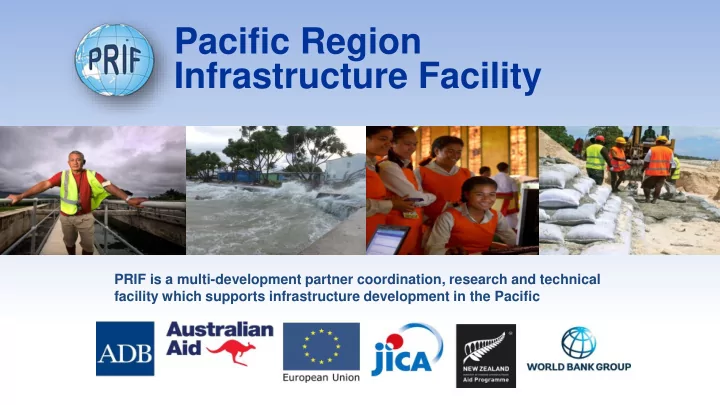

Pacific Region Infrastructure Facility PRIF is a multi-development partner coordination, research and technical facility which supports infrastructure development in the Pacific 1
2
Published in association with: + consulations with industry, governments, regional organisations, stakeholders.
Alternative energy sources for the Pacific Framework for Action on Energy Security in the Pacific (FAESP): 2010 – 2020 • adopted by Pacific Forum Leaders in 2010 Link to Donors' Country Partnership Strategy/ Regional Cooperation Strategy • Energy Leaders’ Summit, Tonga preceding Summit in Auckland, March 2013 • PPA Annual Conference in Palau in July 2013.
SIDS conference – Sept 2014 New sustainable energy partnerships Example: The Secretariat of the Pacific Community (SPC) is the lead regional agency on sustainable energy in the Pacific. Cooking for Life Partnership Mr Solomone Fifita, SPC Partnership between SPC, governments , NGOs, women’s groups, private sector and development partners promotes the use of liquefied petroleum gas and improved, cleaner, safer biomass stoves.
Research – objective and coverage To assess the potential and economic feasibility of LPG, LNG or CNG to meet medium term energy needs in the Pacific, taking into account market conditions affecting uptake
LNG – conclusions Under current market conditions, possibly a viable investment: - for a few of the PICTs. - requires considerable capex in infrastructure - requires new skills and regulations, and extensive marketing to ensure adequate demand - depends on the size of the market, and the relative cost of alternative energy sources - amortisation over the life of the assets with a reasonable rate of return. - PICTs with sufficient fuel demand are Fiji, French Polynesia, Guam & New Caledonia.
LNG – recommendations Potential actions could be considered: - Develop policy frameworks for LNG import and use in relevant countries - Individual power station, IPP, government, gas importer, or consortium could enter into a long-term contract for LNG supply - End-users with >40MW capacity assess bulk LNG import, using floating storage units or floating + regasification unit. - PICT governments could consider facilitating LNG use in transport or industry once LNG infrastructure is established on the back of an ‘anchor demand’ in power generation.
LPG – conclusions Potential to expand and stimulate demand, both domestic and commercial: - grants and/or microfinance initiatives for early market uptake - information campaigns on LPG use - introducing subsidised cylinder exchange/deposit schemes - adopting LPG in schools, hospitals, hotels and via other business customers - developing a niche use for LPG in commercial air conditioning systems - supporting or providing training of installers, contractors and building managers to operate LPG appliances - reduce import duties and tax for LPG relative to household kerosene
LPG – recommendations Expansion of LPG - Accelerate transition from biomass and kerosene to LPG for cooking - Governments consider approaches for developing small piped LPG networks in urban areas to supply LPG for cooking and other purposes. - Help improve economies of scale and create centres of demand. - Governments consider developing LPG options for the transport sector. - Governments consider introducing appropriate incentives for private sector and other stakeholders to increase their LPG import and storage capacities. Both LPG and Natural Gas Utilities and IPPs consider investing in multi-fuel and gaseous fuel injection capability (LNG/natural gas, diesel, HFO, LPG) when buying new generators in relevant countries – for maximum flexibility in future fuel choices with a relatively small incremental cost.
Thank you! Jack Whelan, PRIF jwhelan@theprif.org
Recommend
More recommend